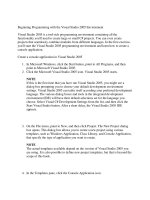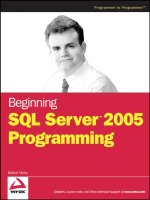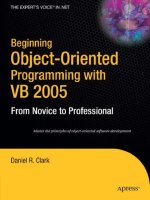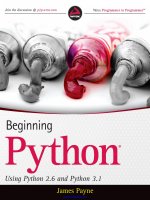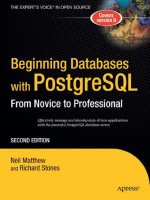vnz 0114 beginning python (2005)
Bạn đang xem bản rút gọn của tài liệu. Xem và tải ngay bản đầy đủ của tài liệu tại đây (15.05 MB, 679 trang )
TEAM LinG
Beginning Python
01_596543 ffirs.qxd 6/29/05 11:00 PM Page i
TEAM LinG
01_596543 ffirs.qxd 6/29/05 11:00 PM Page ii
TEAM LinG
Beginning Python
Peter Norton, Alex Samuel, David Aitel, Eric Foster-Johnson,
Leonard Richardson, Jason Diamond,
Aleatha Parker, Michael Roberts
01_596543 ffirs.qxd 6/29/05 11:00 PM Page iii
TEAM LinG
Beginning Python
Published by
Wiley Publishing, Inc.
10475 Crosspoint Boulevard
Indianapolis, IN 46256
www.wiley.com
Copyright © 2005 by Wiley Publishing, Inc., Indianapolis, Indiana
Published simultaneously in Canada
ISBN-10: 0-7645-9654-3
ISBN-13: 978-0-7645-9654-4
Manufactured in the United States of America
10 9 8 7 6 5 4 3 2 1
1B/SQ/QX/QV/IN
Library of Congress Cataloging-in-Publication Data:
Beginning Python / Peter Norton.
p. cm.
Includes bibliographical references and index.
ISBN-13: 978-0-7645-9654-4 (paper/website)
ISBN-10: 0-7645-9654-3 (paper/website)
1. Python (Computer program language) I. Norton, Peter, 1974-
QA76.73.P98B45 2005
005.13’3 dc22
2005013968
No part of this publication may be reproduced, stored in a retrieval system or transmitted in any form or by any means,
electronic, mechanical, photocopying, recording, scanning or otherwise, except as permitted under Sections 107 or 108 of
the 1976 United States Copyright Act, without either the prior written permission of the Publisher, or authorization
through payment of the appropriate per-copy fee to the Copyright Clearance Center, 222 Rosewood Drive, Danvers, MA
01923, (978) 750-8400, fax (978) 646-8600. Requests to the Publisher for permission should be addressed to the Legal
Department, Wiley Publishing, Inc., 10475 Crosspoint Blvd., Indianapolis, IN 46256, (317) 572-3447, fax (317) 572-4355, or
online at />LIMIT OF LIABILITY/DISCLAIMER OF WARRANTY: THE PUBLISHER AND THE AUTHOR MAKE NO REPRESEN-
TATIONS OR WARRANTIES WITH RESPECT TO THE ACCURACY OR COMPLETENESS OF THE CONTENTS OF
THIS WORK AND SPECIFICALLY DISCLAIM ALL WARRANTIES, INCLUDING WITHOUT LIMITATION WAR-
RANTIES OF FITNESS FOR A PARTICULAR PURPOSE. NO WARRANTY MAY BE CREATED OR EXTENDED BY
SALES OR PROMOTIONAL MATERIALS. THE ADVICE AND STRATEGIES CONTAINED HEREIN MAY NOT BE SUIT-
ABLE FOR EVERY SITUATION. THIS WORK IS SOLD WITH THE UNDERSTANDING THAT THE PUBLISHER IS NOT
ENGAGED IN RENDERING LEGAL, ACCOUNTING, OR OTHER PROFESSIONAL SERVICES. IF PROFESSIONAL
ASSISTANCE IS REQUIRED, THE SERVICES OF A COMPETENT PROFESSIONAL PERSON SHOULD BE SOUGHT.
NEITHER THE PUBLISHER NOR THE AUTHOR SHALL BE LIABLE FOR DAMAGES ARISING HEREFROM. THE
FACT THAT AN ORGANIZATION OR WEBSITE IS REFERRED TO IN THIS WORK AS A CITATION AND/OR A
POTENTIAL SOURCE OF FURTHER INFORMATION DOES NOT MEAN THAT THE AUTHOR OR THE PUBLISHER
ENDORSES THE INFORMATION THE ORGANIZATION OR WEBSITE MAY PROVIDE OR RECOMMENDATIONS IT
MAY MAKE. FURTHER, READERS SHOULD BE AWARE THAT INTERNET WEBSITES LISTED IN THIS WORK MAY
HAVE CHANGED OR DISAPPEARED BETWEEN THEN THIS WORK WAS WRITTEN AND WHEN IT IS READ.
For general information on our other products and services please contact our Customer Care Department within the
United States at (800) 762-2974, outside the United States at (317) 572-3993 or fax (317) 572-4002.
Trademarks: Wiley, the Wiley logo, Wrox, the Wrox logo, Programmer to Programmer, and related trade dress are trade-
marks or registered trademarks of John Wiley & Sons, Inc. and/or its affiliates, in the United States and other countries,
and may not be used without written permission. All other trademarks are the property of their respective owners. Wiley
Publishing, Inc., is not associated with any product or vendor mentioned in this book.
Wiley also publishes its books in a variety of electronic formats. Some content that appears in print may not be available
in electronic books.
01_596543 ffirs.qxd 6/29/05 11:00 PM Page iv
TEAM LinG
About the Authors
Peter Norton (NY, NY) has been working with Unix and Linux for over a decade at companies large and
small solving problems with Linux. An officer of the NY Linux Users Group, he can be found on the
nylug-talk mailing list. Peter coauthored Professional RHEL3. He works for a very large financial com-
pany in NYC, plying his Python and open-source skills.
Alex Samuel (San Diego, CA) has developed software for biology researchers and now studies high-
energy physics at Caltech. Alex has worked on many GNU/Linux development tools, including GCC,
and co-founded CodeSourcery LLC, a consulting firm specializing in GNU/Linux development tools.
David Aitel (NY, NY) is the CEO of Immunity and a coauthor of Shellcoder’s Handbook.
Eric Foster-Johnson (Minneapolis, MN) uses Python extensively with Java, and is a veteran author,
most recently completing Beginning Shell Scripting.
Leonard Richardson (San Francisco, CA) writes useful Python packages with silly names.
Jason Diamond (CA) Jason Diamond is a software development instructor for DevelopMentor and a
consultant specializing in C++, .NET, Python, and XML. He spends most of his spare time contributing
to open-source projects using his favorite language, Python.
Aleathea Parker (San Francisco CA) is a programmer working as a publication engineer for a major
software company, coding primarily in Python and XSLT. She has a background in web applications and
content management.
Michael Roberts (Puerto Rico) has been programming professionally in C, Perl, and Python for long
enough that Python didn’t actually exist when he started. He is the chief perpetrator of the
wftk
open-source workflow toolkit, and he swears that it will someday be finished, for certain values of
“finished”.
01_596543 ffirs.qxd 6/29/05 11:00 PM Page v
TEAM LinG
01_596543 ffirs.qxd 6/29/05 11:00 PM Page vi
TEAM LinG
Credits
Acquisitions Editor
Debra Williams Cauley
Development Editor
Kelly D. Henthorne
Production Editor
William A. Barton
Copy Editor
Luann Rouff
Production Manager
Tim Tate
Editorial Manager
Mary Beth Wakefield
Vice President & Executive Group Publisher
Richard Swadley
Vice President and Publisher
Joseph B. Wikert
Project Coordinator
Kristie Rees
Graphics and Production Specialists
Sean Decker
Carrie Foster
Lauren Goddard
Denny Hager
Jennifer Heleine
Amanda Spagnuolo
Quality Control Technicians
Leann Harney
Joe Niesen
Carl William Pierce
Media Development Specialists
Angela Denny
Kit Malone
Travis Silvers
Proofreading and Indexing
TECHBOOKS Production Services
01_596543 ffirs.qxd 6/29/05 11:00 PM Page vii
TEAM LinG
01_596543 ffirs.qxd 6/29/05 11:00 PM Page viii
TEAM LinG
To my Claudia, for keeping me thinking straight through a crazy time.
To my mom, Eunice, for bringing me food and asking if I was okay throughout.
To Debra, for roping me into this. And to all of the authors,
I want to thank you for making it to the finish line.
Whoa! I didn’t know what I was getting you all into! —P. N.
To my dad, Clarence A. Johnson, 1922–2005. —E. F-J.
For my mother. —L. R.
For Jilly: 1 = 2. —J. D.
To Aaron, for putting up with me. —A. P.
To my wife, Agnes, in revenge for her doctoral thesis. —M. R.
01_596543 ffirs.qxd 6/29/05 11:00 PM Page ix
TEAM LinG
01_596543 ffirs.qxd 6/29/05 11:00 PM Page x
TEAM LinG
Contents
Acknowledgments xxix
Introduction xxxi
Chapter 1: Programming Basics and Strings 1
How Programming Is Different from Using a Computer 1
Programming Is Consistency 2
Programming Is Control 2
Programming Copes with Change 2
What All That Means Together 3
The First Steps 3
Starting codeEditor 3
Using codeEditor’s Python Shell 4
Try It Out: Starting the Python Shell 4
Beginning to Use Python — Strings 5
What Is a String? 5
Why the Quotes? 6
Try It Out: Entering Strings with Different Quotes 6
Understanding Different Quotes 6
Putting Two Strings Together 8
Try It Out: Using + to Combine Strings 8
Putting Strings Together in Different Ways 9
Try It Out: Using a Format Specifier to Populate a String 9
Try It Out: More String Formatting 9
Displaying Strings with Print 10
Try It Out: Printing Text with Print 10
Summary 10
Exercises 11
Chapter 2: Numbers and Operators 13
Different Kinds of Numbers 13
Numbers in Python 14
Try It Out: Using Type with Different Numbers 14
Try It Out: Creating an Imaginary Number 15
02_596543 ftoc.qxd 6/29/05 10:55 PM Page xi
TEAM LinG
xii
Contents
Program Files 15
Try It Out: Using the Shell with the Editor 16
Using the Different Types 17
Try It Out Including Different Numbers in Strings 18
Try It Out: Escaping the % Sign in Strings 18
Basic Math 19
Try It Out Doing Basic Math 19
Try It Out: Using the Modulus Operation 20
Some Surprises 20
Try It Out: Printing the Results 21
Using Numbers 21
Order of Evaluation 21
Try It Out: Using Math Operations 21
Number Formats 22
Try It Out: Using Number Formats 22
Mistakes Will Happen 23
Try It Out: Making Mistakes 23
Some Unusual Cases 24
Try It Out: Formatting Numbers as Octal and Hexadecimal 24
Summary 24
Exercises 25
Chapter 3: Variables — Names for Values 27
Referring to Data – Using Names for Data 27
Try It Out: Assigning Values to Names 28
Changing Data Through Names 28
Try It Out: Altering Named Values 29
Copying Data 29
Names You Can’t Use and Some Rules 29
Using More Built-in Types 30
Tuples —Unchanging Sequences of Data 30
Try It Out: Creating and Using a Tuple 30
Try It Out: Accessing a Tuple Through Another Tuple 31
Lists —Changeable Sequences of Data 33
Try It Out Viewing the Elements of a List 33
Dictionaries —Groupings of Data Indexed by Name 34
Try It Out: Making a Dictionary 34
Try It Out: Getting the Keys from a Dictionary 35
Treating a String Like a List 36
Special Types 38
02_596543 ftoc.qxd 6/29/05 10:55 PM Page xii
TEAM LinG
xiii
Contents
Other Common Sequence Properties 38
Referencing the Last Elements 38
Ranges of Sequences 39
Try It Out: Slicing Sequences 39
Growing Lists by Appending Sequences 40
Using Lists to Temporarily Store Data 40
Try It Out: Popping Elements from a List 40
Summary 41
Exercises 42
Chapter 4: Making Decisions 43
Comparing Values —Are They the Same? 43
Try It Out: Comparing Values for Sameness 43
Doing the Opposite — Not Equal 45
Try It Out: Comparing Values for Difference 45
Comparing Values —Which One Is More? 45
Try It Out: Comparing Greater Than and Less Than 45
More Than or Equal, Less Than or Equal 47
Reversing True and False 47
Try It Out: Reversing the Outcome of a Test 47
Looking for the Results of More Than One Comparison 48
How to Get Decisions Made 48
Try It Out: Placing Tests within Tests 49
Repetition 51
How to Do Something —Again and Again 51
Try It Out: Using a while Loop 51
Stopping the Repetition 52
Try It Out: Using else While Repeating 54
Try It Out: Using continue to Keep Repeating 54
Handling Errors 55
Trying Things Out 55
Try It Out: Creating an Exception with Its Explanation 56
Summary 57
Exercises 58
Chapter 5: Functions 59
Putting Your Program into Its Own File 59
Try It Out: Run a Program with Python -i 61
02_596543 ftoc.qxd 6/29/05 10:55 PM Page xiii
TEAM LinG
xiv
Contents
Functions: Grouping Code under a Name 61
Try It Out: Defining a Function 61
Choosing a Name 62
Describing a Function in the Function 63
Try It Out: Displaying __doc__ 63
The Same Name in Two Different Places 64
Making Notes to Yourself 65
Try It Out: Experimenting with Comments 65
Asking a Function to Use a Value You Provide 66
Try It Out Invoking a Function with Parameters 67
Checking Your Parameters 68
Try It Out: Determining More Types with the type Function 69
Try It Out: Using Strings to Compare Types 69
Setting a Default Value for a Parameter — Just in Case 70
Try It Out: Setting a Default Parameter 70
Calling Functions from within Other Functions 71
Try It Out: Invoking the Completed Function 72
Functions Inside of Functions 72
Flagging an Error on Your Own Terms 73
Layers of Functions 74
How to Read Deeper Errors 74
Summary 75
Exercises 76
Chapter 6: Classes and Objects 79
Thinking About Programming 79
Objects You Already Know 79
Looking Ahead: How You Want to Use Objects 81
Defining a Class 81
How Code Can Be Made into an Object 81
Try It Out: Defining a Class 82
Try It Out: Creating an Object from Your Class 82
Try It Out: Writing an Internal Method 84
Try It Out: Writing Interface Methods 85
Try It Out: Using More Methods 87
Objects and Their Scope 89
Try It Out: Creating Another Class 89
Summary 92
Exercises 93
02_596543 ftoc.qxd 6/29/05 10:55 PM Page xiv
TEAM LinG
xv
Contents
Chapter 7: Organizing Programs 95
Modules 96
Importing a Module So That You Can Use It 96
Making a Module from Pre-existing Code 97
Try It Out: Creating a Module 97
Try It Out: Exploring Your New Module 98
Using Modules —Starting With the Command Line 99
Try It Out: Printing sys.argv 100
Changing How Import Works —Bringing in More 101
Packages 101
Try It Out: Making the Files in the Kitchen Class 102
Modules and Packages 103
Bringing Everything into the Current Scope 103
Try It Out: Exporting Modules from a Package 104
Re-importing Modules and Packages 104
Try It Out: Examining sys.modules 105
Basics of Testing Your Modules and Packages 106
Summary 106
Exercises 107
Chapter 8: Files and Directories 109
File Objects 109
Writing Text Files 110
Reading Text Files 111
Try It Out: Printing the Lengths of Lines in the Sample File 112
File Exceptions 113
Paths and Directories 113
Paths 114
Directory Contents 116
Try It Out: Getting the Contents of a Directory 116
Try It Out: Listing the Contents of Your Desktop or Home Directory 118
Obtaining Information about Files 118
Recursive Directory Listings 118
Renaming, Moving, Copying, and Removing Files 119
Example: Rotating Files 120
Creating and Removing Directories 121
Globbing 122
02_596543 ftoc.qxd 6/29/05 10:55 PM Page xv
TEAM LinG
xvi
Contents
Pickles 123
Try It Out: Creating a Pickle File 123
Pickling Tips 124
Efficient Pickling 125
Summary 125
Exercises 125
Chapter 9: Other Features of the Language 127
Lambda and Filter: Short Anonymous Functions 127
Reduce 128
Try It Out: Working with Reduce 128
Map: Short-Circuiting Loops 129
Try It Out: Use Map 129
Decisions within Lists — List Comprehension 130
Generating Lists for Loops 131
Try It Out: Examining an xrange Object 132
Special String Substitution Using Dictionaries 133
Try It Out: String Formatting with Dictionaries 133
Featured Modules 134
Getopt —Getting Options from the Command Line 134
Using More Than One Process 137
Threads —Doing Many Things in the Same Process 139
Storing Passwords 140
Summary 141
Exercises 142
Chapter 10: Building a Module 143
Exploring Modules 143
Importing Modules 145
Finding Modules 145
Digging through Modules 146
Creating Modules and Packages 150
Try It Out: Creating a Module with Functions 150
Working with Classes 151
Defining Object-Oriented Programming 151
Creating Classes 151
Try It Out: Creating a Meal Class 152
Extending Existing Classes 153
02_596543 ftoc.qxd 6/29/05 10:55 PM Page xvi
TEAM LinG
xvii
Contents
Finishing Your Modules 154
Defining Module-Specific Errors 154
Choosing What to Export 155
Documenting Your Modules 156
Try It Out: Viewing Module Documentation 157
Testing Your Module 162
Running a Module as a Program 164
Try It Out: Running a Module 164
Creating a Whole Module 165
Try It Out: Finishing a Module 165
Try It Out: Smashing Imports 169
Installing Your Modules 170
Try It Out: Creating an Installable Package 171
Summary 174
Exercises 174
Chapter 11: Text Processing 175
Why Text Processing Is So Useful 175
Searching for Files 176
Clipping Logs 177
Sifting through Mail 178
Navigating the File System with the os Module 178
Try It Out: Listing Files and Playing with Paths 180
Try It Out: Searching for Files of a Particular Type 181
Try It Out: Refining a Search 183
Working with Regular Expressions and the re Module 184
Try It Out: Fun with Regular Expressions 186
Try It Out: Adding Tests 187
Summary 189
Exercises 189
Chapter 12: Testing 191
Assertions 191
Try It Out: Using Assert 192
Test Cases and Test Suites 193
Try It Out: Testing Addition 194
Try It Out: Testing Faulty Addition 195
Test Fixtures 196
Try It Out: Working with Test Fixtures 197
02_596543 ftoc.qxd 6/29/05 10:55 PM Page xvii
TEAM LinG
xviii
Contents
Putting It All Together with Extreme Programming 199
Implementing a Search Utility in Python 200
Try It Out: Writing a Test Suite First 201
Try It Out: A General-Purpose Search Framework 203
A More Powerful Python Search 205
Try It Out: Extending the Search Framework 206
Formal Testing in the Software Life Cycle 207
Summary 208
Chapter 13: Writing a GUI with Python 209
GUI Programming Toolkits for Python 209
PyGTK Introduction 210
pyGTK Resources 211
Creating GUI Widgets with pyGTK 213
Try It Out: Writing a Simple pyGTK Program 213
GUI Signals 214
GUI Helper Threads and the GUI Event Queue 216
Try It Out: Writing a Multithreaded pyGTK App 219
Widget Packing 222
Glade: a GUI Builder for pyGTK 223
GUI Builders for Other GUI Frameworks 224
Using libGlade with Python 225
A Glade Walkthrough 225
Starting Glade 226
Creating a Project 227
Using the Palette to Create a Window 227
Putting Widgets into the Window 228
Glade Creates an XML Representation of the GUI 230
Try It Out: Building a GUI from a Glade File 231
Creating a Real Glade Application 231
Advanced Widgets 238
Further Enhancing PyRAP 241
Summary 248
Exercises 248
Chapter 14: Accessing Databases 249
Working with DBM Persistent Dictionaries 250
Choosing a DBM Module 250
Creating Persistent Dictionaries 251
Try It Out: Creating a Persistent Dictionary 251
02_596543 ftoc.qxd 6/29/05 10:55 PM Page xviii
TEAM LinG
xix
Contents
Accessing Persistent Dictionaries 252
Try It Out: Accessing Persistent Dictionaries 253
Deciding When to Use DBM and When to Use a Relational Database 255
Working with Relational Databases 255
Writing SQL Statements 257
Defining Tables 259
Setting Up a Database 260
Try It Out: Creating a Gadfly Database 261
Using the Python Database APIs 262
Downloading Modules 263
Creating Connections 263
Working with Cursors 264
Try It Out: Inserting Records 264
Try It Out: Writing a Simple Query 266
Try It Out: Writing a Complex Join 267
Try It Out: Updating an Employee’s Manager 269
Try It Out: Removing Employees 270
Working with Transactions and Committing the Results 271
Examining Module Capabilities and Metadata 272
Handling Errors 272
Summary 273
Exercises 274
Chapter 15: Using Python for XML 275
What Is XML? 275
A Hierarchical Markup Language 275
A Family of Standards 277
What Is a Schema/DTD? 278
What Are Document Models For? 278
Do You Need One? 278
Document Type Definitions 278
An Example DTD 278
DTDs Aren’t Exactly XML 280
Limitations of DTDs 280
Schemas 280
An Example Schema 280
Schemas Are Pure XML 281
Schemas Are Hierarchical 281
Other Advantages of Schemas 281
Schemas Are Less Widely Supported 281
02_596543 ftoc.qxd 6/29/05 10:55 PM Page xix
TEAM LinG
xx
Contents
XPath 282
HTML as a Subset of XML 282
The HTML DTDs 283
HTMLParser 283
Try It Out: Using HTMLParser 283
htmllib 284
Try It Out: Using htmllib 284
XML Libraries Available for Python 285
Validating XML Using Python 285
What Is Validation? 286
Well-Formedness versus Validation 286
Available Tools 286
Try It Out: Validation Using xmlproc 286
What Is SAX? 287
Stream-based 288
Event-driven 288
What Is DOM? 288
In-memory Access 288
Why Use SAX or DOM 289
Capability Trade-Offs 289
Memory Considerations 289
Speed Considerations 289
SAX and DOM Parsers Available for Python 289
PyXML 290
xml.sax 290
xml.dom.minidom 290
Try It Out: Working with XML Using DOM 290
Try It Out: Working with XML Using SAX 292
Intro to XSLT 293
XSLT Is XML 293
Transformation and Formatting Language 293
Functional, Template-Driven 293
Using Python to Transform XML Using XSLT 294
Try It Out: Transforming XML with XSLT 294
Putting It All Together: Working with RSS 296
RSS Overview and Vocabulary 296
Making Sense of It All 296
RSS Vocabulary 297
An RSS DTD 297
02_596543 ftoc.qxd 6/29/05 10:55 PM Page xx
TEAM LinG
xxi
Contents
A Real-World Problem 297
Try It Out: Creating an RSS Feed 298
Creating the Document 300
Checking It Against the DTD 301
Another Real-World Problem 301
Try It Out: Creating An Aggregator 301
Summary 303
Exercises 303
Chapter 16: Network Programming 305
Try It Out: Sending Some E-mail 305
Understanding Protocols 307
Comparing Protocols and Programming Languages 307
The Internet Protocol Stack 308
A Little Bit About the Internet Protocol 309
Internet Addresses 309
Internet Ports 310
Sending Internet E-mail 311
The E-mail File Format 311
MIME Messages 313
MIME Encodings: Quoted-printable and Base64 313
MIME Content Types 314
Try It Out: Creating a MIME Message with an Attachment 315
MIME Multipart Messages 316
Try It Out: Building E-mail Messages with SmartMessage 320
Sending Mail with SMTP and smtplib 321
Try It Out: Sending Mail with MailServer 323
Retrieving Internet E-mail 323
Parsing a Local Mail Spool with mailbox 323
Try It Out: Printing a Summary of Your Mailbox 324
Fetching Mail from a POP3 Server with poplib 325
Try It Out: Printing a Summary of Your POP3 Mailbox 327
Fetching Mail from an IMAP Server with imaplib 327
Try It Out: Printing a Summary of Your IMAP Mailbox 329
IMAP’s Unique Message IDs 330
Try It Out: Fetching a Message by Unique ID 330
Secure POP3 and IMAP 331
Webmail Applications Are Not E-mail Applications 331
Socket Programming 331
Introduction to Sockets 332
Try It Out: Connecting to the SuperSimpleSocketServer with Telnet 333
02_596543 ftoc.qxd 6/29/05 10:55 PM Page xxi
TEAM LinG
xxii
Contents
Binding to an External Hostname 334
The Mirror Server 335
Try It Out: Mirroring Text with the MirrorServer 336
The Mirror Client 336
SocketServer 337
Multithreaded Servers 339
The Python Chat Server 340
Design of the Python Chat Server 340
The Python Chat Server Protocol 341
Our Hypothetical Protocol in Action 341
Initial Connection 342
Chat Text 342
Server Commands 342
General Guidelines 343
The Python Chat Client 346
Single-Threaded Multitasking with select 348
Other Topics 350
Miscellaneous Considerations for Protocol Design 350
Trusted Servers 350
Terse Protocols 350
The Twisted Framework 351
Deferred Objects 351
The Peer-to-Peer Architecture 354
Summary 354
Exercises 354
Chapter 17: Extension Programming with C 355
Extension Module Outline 356
Building and Installing Extension Modules 358
Passing Parameters from Python to C 360
Returning Values from C to Python 363
The LAME Project 364
The LAME Extension Module 368
Using Python Objects from C Code 380
Summary 383
Exercises 383
Chapter 18: Writing Shareware and Commercial Programs 385
A Case Study: Background 385
How Much Python Should You Use? 386
02_596543 ftoc.qxd 6/29/05 10:55 PM Page xxii
TEAM LinG
xxiii
Contents
Pure Python Licensing 387
Web Services Are Your Friend 388
Pricing Strategies 389
Watermarking 390
Other Models 394
Selling as a Platform, Rather Than a Product 395
Your Development Environment 395
Finding Python Programmers 396
Training non-Python Programmers 397
Python Employment Resources 397
Python Problems 397
Porting to Other Versions of Python 397
Porting to Other Operating Systems 398
Debugging Threads 399
Common Gotchas 399
Portable Distribution 400
Essential Libraries 401
Timeoutsocket 401
PyGTK 402
GEOip 402
Summary 403
Chapter 19: Numerical Programming 405
Numbers in Python 405
Integers 406
Long Integers 406
Floating-point Numbers 407
Formatting Numbers 408
Characters as Numbers 410
Mathematics 412
Arithmetic 412
Built-in Math Functions 414
The math Module 415
Complex Numbers 416
Arrays 418
The array Module 420
The numarray Package 422
Using Arrays 422
Computing the Standard Deviation 423
Summary 424
Exercises 425
02_596543 ftoc.qxd 6/29/05 10:55 PM Page xxiii
TEAM LinG
xxiv
Contents
Chapter 20: Python in the Enterprise 427
Enterprise Applications 428
Document Management 428
The Evolution of Document Management Systems 429
What You Want in a Document Management System 430
People in Directories 431
Taking Action with Workflow 432
Auditing, Sarbanes-Oxley, and What You Need to Know 433
Auditing and Document Management 434
Working with Actual Enterprise Systems 435
Introducing the wftk Workflow Toolkit 435
Try It Out: Very Simple Record Retrieval 436
Try It Out: Very Simple Record Storage 438
Try It Out: Data Storage in MySQL 439
Try It Out: Storing and Retrieving Documents 441
Try It Out: A Document Retention Framework 446
The python-ldap Module 448
Try It Out: Using Basic OpenLDAP Tools 449
Try It Out: Simple LDAP Search 451
More LDAP 453
Back to the wftk 453
Try It Out: Simple Workflow Trigger 454
Try It Out: Action Queue Handler 456
Summary 458
Exercises 458
Chapter 21: Web Applications and Web Services 459
REST: The Architecture of the Web 460
Characteristics of REST 460
A Distributed Network of Interlinked Documents 461
A Client-Server Architecture 461
Servers Are Stateless 461
Resources 461
Representations 462
REST Operations 462
HTTP: Real-World REST 463
Try It Out: Python’s Three-Line Web Server 463
The Visible Web Server 464
Try It Out: Seeing an HTTP Request and Response 465
The HTTP Request 466
The HTTP Response 467
02_596543 ftoc.qxd 6/29/05 10:55 PM Page xxiv
TEAM LinG


